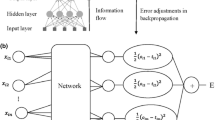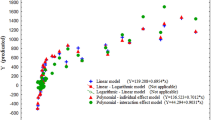Abstract
This paper presents a predictive model for electrochemical impedance Nyquist plots using artificial neural network. The proposed model obtains predictions of imaginary impedance based on the real part of the impedance as a function of time. The model takes into account the variations of the real impedance and immersion time of steel in a corrosive environment, considering constant carboxyamido-imidazoline corrosion inhibitor concentrations (5 and 25 ppm). For the network, the Levenberg–Marquardt learning algorithm, the hyperbolic tangent sigmoid transfer function, and the linear transfer function were used. The best-fitting training data set was obtained with five neurons in the hidden layer for 5 ppm of inhibitor and two neurons in the hidden layer for 25 ppm of inhibitor, which made it possible to predict the efficiency with accuracy at least as good as that of the theoretical error, over the whole theoretical range. On the validation data set, simulations and theoretical data test were in good agreement with an R value of 0.984 for 5 ppm and 0.994 for 25 ppm of inhibitor. The developed model can be used for the prediction of the real and imaginary parts of the impedance as a function of time for short simulation times.











Similar content being viewed by others
References
Kermani MB, Morshed A (2003) Corrosion 59:659
Xue-Yuan Z, Feng-Ping W, Yu-Fang H, Yuan-Long D (2001) Corros Sci 43:1417. doi:10.1016/S0010-938X(00)00160-8
Bentiss F, Lagrenee M, Traisnel M, Hornez JC (1999) Corros Sci 41:789. doi:10.1016/S0010-938X(98)00153-X
Rosenfeld IL, Bongomolov DB, Gorodetskii AE, Kazanskii LP, Frolova LV, Shamova LI (1982) Zaschita Metallov 18:163
Colorado-Garrido D, Ortega-Toledo DM, Hernández JA, González-Rodríguez JG (2007) Proceedings of the CERMA, Electronics, Robotics and Automotive Mechanics Conference, Cuernavaca, Morelos, Mexico, p 213
Vanderplaats GN (1984) Numerical optimization techniques for engineering design. McGraw-Hill, New York
Hornik K, Stinchcombe M, White H (1989) Neural Netw 2:359. doi:10.1016/0893-6080(89)90020-8
Hernández-Pérez JA, García-Alvarado MA, Trystram G, Heyd B (2004) Innovative Food Science and Emerging Technologies 5:57. doi:10.1016/j.ifset.2003.10.004
Natrick MA (1998) in Demuth H, Beale M (eds) Neural network toolbox for Matlab—user’s guide. The Math Works, Natick, MA
Martin T, Hagan MT, Mohammad BN (1994) IEEE Trans Neural Netw 6:989
Ortega-Toledo DM (2007) An electrochemical study of the CO2 corrosion inhibition of a pipeline steel for crude oil (Estudio electroquímico de la inhibición de la corrosión por CO2 de un acero para ductos de petróleo crudo). M.Sc. dissertation, Autonomus University of Morelos State, México
Neter J, Kunter MH, Nachtsheim CJ, Wsserman W (1996) Applied linear statistical models, 4th edn. McGraw-Hill, USA
Author information
Authors and Affiliations
Corresponding author
Rights and permissions
About this article
Cite this article
Colorado-Garrido, D., Ortega-Toledo, D.M., Hernández, J.A. et al. Neural networks for Nyquist plots prediction during corrosion inhibition of a pipeline steel. J Solid State Electrochem 13, 1715–1722 (2009). https://doi.org/10.1007/s10008-008-0728-7
Received:
Revised:
Accepted:
Published:
Issue Date:
DOI: https://doi.org/10.1007/s10008-008-0728-7




